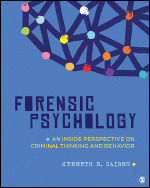You are in: Caribbean
Change location
You are here
Balancing Research with Experience Working on Death Row
AN INSIGHTFUL APPROACH TO TEACHING
Bricks and Mortar: Balancing Research with Experience in Forensic Psychology
By Kenneth B. Cairns, assistant professor of Criminal Justice, forensic psychologist, and author of Forensic Psychology: An Inside Perspective on Criminal Thinking and Behavior

I never imagined that one day I would end up on Death Row. But there I was, on the Capital Case Unit, AKA “Death Row” in the Western Penitentiary in Pittsburgh, Pennsylvania.
I had interviewed for and been hired as a psychologist to work in the Pennsylvania Department of Corrections. The difficulty was that in all the many years I had gone to school, I had never taken even a single course in forensics, criminology, or corrections. I was in graduate school in the late 1980s and early 1990s; I’m not entirely sure the term “forensic psychology” even existed at that time. If it did, it was rarely used and certainly I was not being bombarded by the numerous television programs, movies, and Netflix specials about serial killers, behavioral analysis, and crime scene investigation that we see today.
Research: The bricks
Despite my lack of training, I had been hired to work as a psychologist in the prison system. So, I did what any good psychologist would do. I began reading. I got my hands on every scholarly book and article that I could. I read about recidivism rates, racial disparities in sentencing, the psychological impact of solitary confinement, and the prevalence of drug and alcohol addiction in incarcerated populations. I did my best to bring myself up to speed on what research and data tell us about forensics in general and about incarcerated individuals specifically.
As the years went by, however, I found that no matter how good a particular meta-analysis might be, no matter what prestigious university had produced a certain journal article, there were times when the research fell short of the human reality that I was seeing every day.
Personal experience: The mortar
I found research that showed that cognitive behavioral therapy could be effective in teaching those who are incarcerated to think, feel, and act differently. But I also remember a drug dealer who explicitly told me that he had no interest or desire to change in any way. I read studies that showed that extended solitary confinement could result in severe mental illness. But those studies failed to convey the tragedy of a man huddled in the corner of his solitary confinement cell, rocking back and forth in a puddle of his own urine.
Research and data are the bricks that form the foundation of any attempt to understand and to teach forensics. Just like the bricks that make up the foundation of a house, the house cannot exist without them. But bricks by themselves are not enough. If all we do is stack those bricks up, without mortar to hold them together, the house will fall.
Effective teaching: Putting the bricks and mortar together
It’s important that we teach our students, that we tell our readers, about the bricks. That we cite facts, research, and data. But that by itself is not enough. We have all likely seen students whose eyes are glazing over in class as we recite one study after another after another. I certainly have.
In my writing, in teaching college and graduate classes, I am now very careful to make sure there is mortar holding the bricks together. For me, it is important to tell my students about research on the Death Penalty, or on the incarceration of pregnant women, or solitary confinement. Before their eyes begin to glaze over, I’ve also found it’s important to speak to them from the personal experiences I’ve had during my career, to describe to them both the drug dealer who didn’t want to change and the poor man huddled in the corner of his cell.
Only if we give students both the bricks and the mortar can they really understand what we are telling them.

